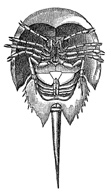 Their Moment in the Sands
Their Moment in the Sands
They were unabashedly engaged in their procreation dance, which was more like a slow-motion waltz performed by mannequins. It was, however, interesting enough to catch the eye of my Chessie, Huck, who usually is so engrossed in his own genetic calling — fetching things — to notice such high jinx. These barnacle-encrusted horseshoe crabs crawled onto the beach near my uncle’s home to breed, looking roughly as they did 360 million years ago.
When horseshoe crabs aren’t hosting their own version of beach blanket bingo in the late spring, they live on the bottom. As part of the largest group of all living animals, arthropods, horseshoe crabs have more in common with spiders and scorpions than crabs. Like other arachnids, horseshoe crabs have book gills and five pairs of legs.
Though horseshoes range from the Yucatan peninsula to northern Maine, mostly they live in the mid-Atlantic region. In our Bay, horseshoe crabs are year-round residents near the mouth as well as visitors to Eastern Bay, Miles, Chester and Choptank rivers. Researchers believe that within each major estuary along the Atlantic, distinct populations can be distinguished from others by size, shell color and eye pigmentation.
Horseshoe crabs’ role in the ecosystem is under-appreciated. Juvenile loggerhead turtles, a threatened species that uses the Chesapeake as a summer nursery, feed on them. Crab eggs nourish migrating shorebirds, which researchers estimate consume nearly 320 tons of eggs annually. Adult horseshoe crabs feed primarily on marine worms and shellfish, including razor clams and soft-shelled clams.
Horseshoe crabs also serve an important role in the medical field. Limulus amoebocyte lysate, a clotting agent found in horseshoe crab blood, is used by scientists to detect such human pathogens as spinal meningitis and gonorrhea.
Commercial fishermen use them for eel, conch and catfish bait. Maryland has accounted for between 23 percent and 78 percent of the commercial catch from the northeastern Atlantic since 1980. But the unregulated fishery raised flags for resource managers, and in April 1998 Maryland restricted the coastal ocean harvest by 70 percent. Now, the Atlantic States Marine Fisheries Commission has proposed a 25 percent reduction in the horseshoe crab catch in every Atlantic state to further stem the tide of over-fishing.
So if you happen upon horseshoe crabs, let them enjoy their moment in the sand.
Fish Are Biting
It’s hot as Hades out there, making it seem more like late August than mid June. My advice is to escape the crowds and head to southern waters: fish the rivers, kayak the shorelines.
If you prefer open waters, speckled trout, red drum, croaker and rock are abundant from Smith Island to Fisherman’s Island. Offshore, several Ocean City marinas are reporting that anglers caught mako sharks up to 100 pounds at the Washington Canyon. Chumming was the preferred method.